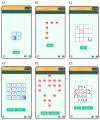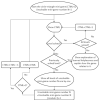Serious Games Based on Cognitive Bias Modification and Learned Helplessness Paradigms for the Treatment of Depression: Design and Acceptability Study
- PMID: 37133923
- PMCID: PMC10193222
- DOI: 10.2196/37105
Serious Games Based on Cognitive Bias Modification and Learned Helplessness Paradigms for the Treatment of Depression: Design and Acceptability Study
Abstract
Background: Depression is a debilitating mental health disorder, with a large treatment gap. Recent years have seen a surge in digital interventions to bridge this treatment gap. Most of these interventions are based on computerized cognitive behavioral therapy. Despite the efficacy of computerized cognitive behavioral therapy-based interventions, their uptake is low and dropout rates are high. Cognitive bias modification (CBM) paradigms provide a complementary approach to digital interventions for depression. However, interventions based on CBM paradigms have been reported to be repetitive and boring.
Objective: In this paper, we described the conceptualization, design, and acceptability of serious games based on CBM paradigms and the learned helplessness paradigm.
Methods: We searched the literature for CBM paradigms that were shown to be effective in reducing depressive symptoms. For each of the CBM paradigms, we ideated how to create a game so that the gameplay was engaging while the active therapeutic component remained unchanged.
Results: We developed 5 serious games based on the CBM paradigms and the learned helplessness paradigm. The games include various core elements of gamification, such as goals, challenges, feedback, rewards, progress, and fun. Overall, the games received positive acceptability ratings from 15 users.
Conclusions: These games may help improve the effectiveness and engagement levels of computerized interventions for depression.
Keywords: cognitive bias modification; depression; digital intervention; learned helplessness; mobile phone; serious games.
©Arka Ghosh, Jagriti Agnihotri, Sradha Bhalotia, Bharat Kumar Sati, Latika Agarwal, Akash A, Swastika Tandon, Komal Meena, Shreyash Raj, Yatin Azad, Silky Gupta, Nitin Gupta. Originally published in JMIR Serious Games (https://games.jmir.org), 03.05.2023.
Conflict of interest statement
Conflicts of Interest: None declared.
Figures








References
-
- GBD 2017 Disease and Injury Incidence and Prevalence Collaborators Global, regional, and national incidence, prevalence, and years lived with disability for 354 diseases and injuries for 195 countries and territories, 1990-2017: a systematic analysis for the Global Burden of Disease Study 2017. Lancet. 2018 Nov 10;392(10159):1789–858. doi: 10.1016/S0140-6736(18)32279-7. https://linkinghub.elsevier.com/retrieve/pii/S0140-6736(18)32279-7 S0140-6736(18)32279-7 - DOI - PMC - PubMed
-
- Cipriani A, Furukawa TA, Salanti G, Chaimani A, Atkinson LZ, Ogawa Y, Leucht S, Ruhe HG, Turner EH, Higgins JP, Egger M, Takeshima N, Hayasaka Y, Imai H, Shinohara K, Tajika A, Ioannidis JP, Geddes JR. Comparative efficacy and acceptability of 21 antidepressant drugs for the acute treatment of adults with major depressive disorder: a systematic review and network meta-analysis. Lancet. 2018 Apr 07;391(10128):1357–66. doi: 10.1016/S0140-6736(17)32802-7. https://boris.unibe.ch/id/eprint/112281 S0140-6736(17)32802-7 - DOI - PMC - PubMed
-
- Hofmann SG, Asnaani A, Vonk IJ, Sawyer AT, Fang A. The efficacy of cognitive behavioral therapy: a review of meta-analyses. Cognit Ther Res. 2012 Oct 01;36(5):427–40. doi: 10.1007/s10608-012-9476-1. https://europepmc.org/abstract/MED/23459093 - DOI - PMC - PubMed
-
- Andrade LH, Alonso J, Mneimneh Z, Wells JE, Al-Hamzawi A, Borges G, Bromet E, Bruffaerts R, de Girolamo G, de Graaf R, Florescu S, Gureje O, Hinkov HR, Hu C, Huang Y, Hwang I, Jin R, Karam EG, Kovess-Masfety V, Levinson D, Matschinger H, O'Neill S, Posada-Villa J, Sagar R, Sampson NA, Sasu C, Stein DJ, Takeshima T, Viana MC, Xavier M, Kessler RC. Barriers to mental health treatment: results from the WHO World Mental Health surveys. Psychol Med. 2013 Aug 09;44(6):1303–17. doi: 10.1017/s0033291713001943. - DOI - PMC - PubMed
LinkOut - more resources
Full Text Sources
Miscellaneous

